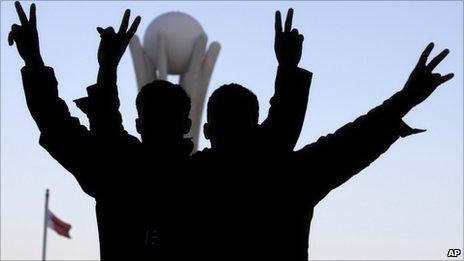Day of transformation in Bahrain's 'sacred square'
- Published

Thousands have taken part in protests in recent days, calling for reforms
Euphoric protesters in Bahrain have re-entered Pearl Square in Manama after security forces pulled out following a deadly crackdown. For many of them, it was viewed as a definitive moment in their struggle, as the BBC's Allan Little reports.
The first sign was a column of military vehicles - dozens of armoured personnel carriers, trucks, jeeps - taking to the highway. We met them as we were driving back into the city centre; they were leaving town on the orders of the crown prince.
Within hours, the protesters had begun again to make their way to Pearl Square.
Their mood was inflamed by what had happened last night, when dozens of people were admitted to hospital after police opened fire on a peaceful demonstration. One man was shot in the head. Doctors said he was unlikely to survive.
Today protesters said, again and again, that they were ready to risk their lives. They had walked - knowing the risk they were running - into the guns of the security forces before, and were ready to do so again.
In the end it was the government - under intense international pressure - that could not take the risk.
At mid-afternoon, the police - more hated and feared here than the military - simply got into their vehicles and drove away. The barricades separating the people from Pearl Square vanished.
Banners, flowers and flags
The moment astonished even those who were ready to seize it with both hands.
One young woman told me, overcome almost to the point of tears, that it meant freedom.
"This is our country," she screamed.
"We started our protest here in Pearl Square, and we will stay here until we have secured our reforms."
They poured into the square waving banners, flowers, placards and the red and white flag of the Kingdom of Bahrain. It is the anger of the young that has driven this protest, but this was a movement that embraced young and old alike, women as well as men, Sunni as well as Shia.
We watched as many of those gathering in the square then got onto their hands and knees, some to pray, others simply to kiss the ground. Make no mistake: Pearl Square has become a sacred place for the protesters.
There is also a striking uniformity in what the people gathered there say they want. There is little appetite for the abolition of the monarchy; they want, instead, its reform.
"The monarchy has to reform or be thrown away," opposition leader Ebrahim Sherrif told me earlier in the day. Mr Sherrif will play a major role in the negotiations with the government that will now begin.
"We not saying to the royal family 'you're not part of this society'. We are saying 'you are welcome to be equal, but not to be above the law'. We don't want to overthrow the monarchy.
"We'd like to see a UK- or Spanish-style constitutional monarchy. A republic does not solve the problem - we had republics in Tunisia and Egypt and they were the first to be overthrown," he said.
The occupation of Pearl Square felt, in the euphoria of the moment, like the end of a long struggle. It was not. It is simply the beginning of what could be a protracted negotiation between power and the people.
"Pearl Square has great significance," says Mr Sherrif.
"If it is controlled by the young people, you have continuous pressure on the government. People have learned that from the Egyptian experience. It will force the government into serious negotiation," he added.
Tonight - in open emulation of Cairo's Tahrir Square - the protesters are digging in for a long wait at Pearl Square, bringing tents, food, cooking equipment.
It has been, for them, a transforming day.